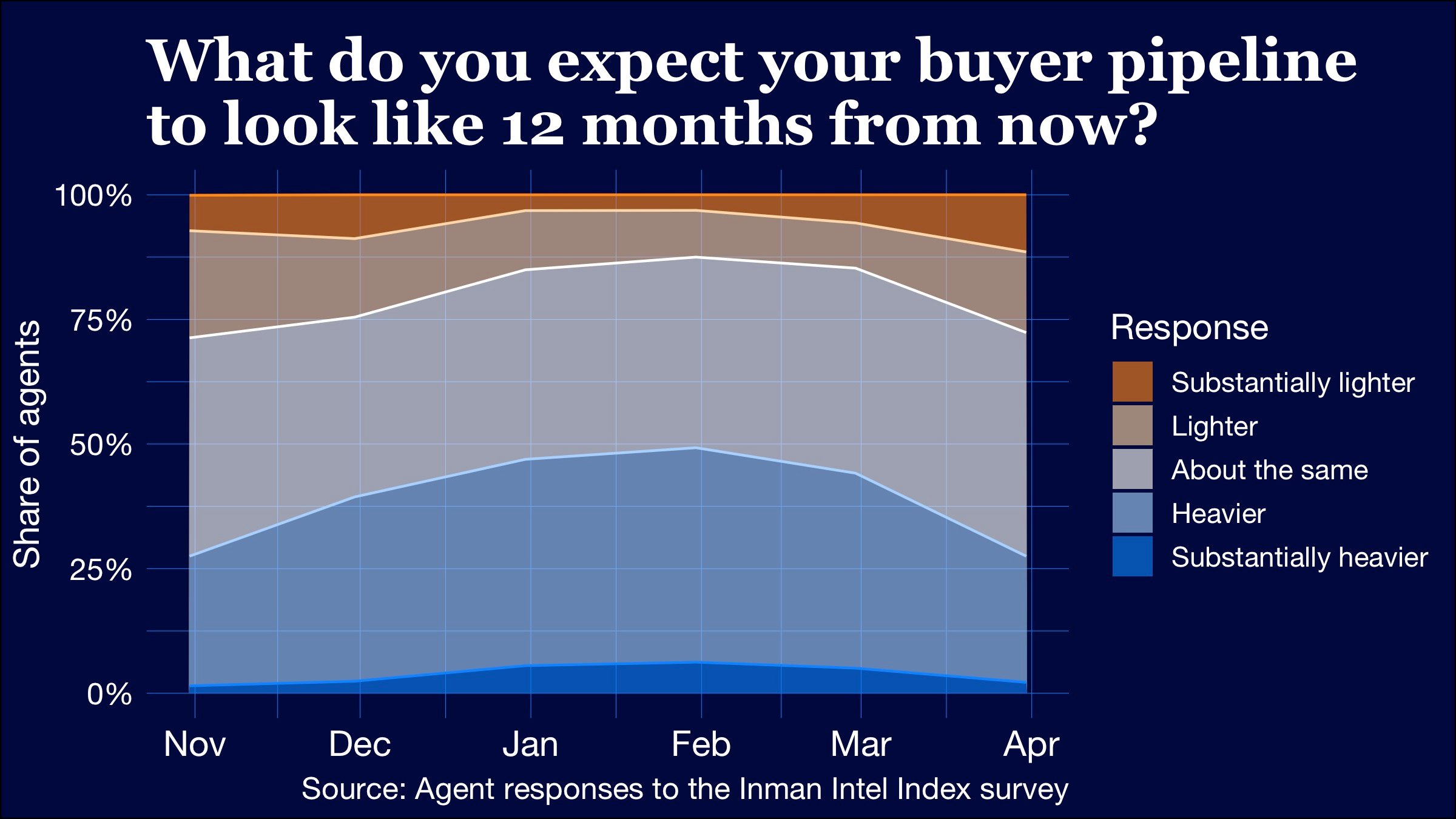- Originally published at Inman News - Daniel Houston
Agent optimism over future buyer pipelines fell from 44 percent before the deal to 27 percent afterward — one of the starkest monthly shifts in sentiment that Intel has recorded in the last year.
This report is available exclusively to subscribers of Inman Intel, the data and research arm of Inman offering deep insights and market intelligence on the business of residential real estate and proptech. Subscribe today.
Not much has changed. Nothing will ever be the same.
Agents say they are coming to terms with these conflicting realities as they face a depressed market that has seemed to barely budge alongside new policies that many believe could hurt their prospects of courting buyers in the future.
The National Association of Realtors settlement appears to have prompted an immediate downward shift in agent optimism toward their buyer pipelines, according to responses to the Inman Intel Index survey shortly after the deal became public in March.
- Agents expressing optimism that their buyer pipelines would recover in the next 12 months plummeted from 44 percent in February to 27 percent in March.
- Meanwhile, pessimistic attitudes toward future buyer pipelines spiked from 15 percent in February to 28 percent after the NAR deal was announced.
TAKE THE INMAN INTEL INDEX SURVEY FOR APRIL
This represents one of the starkest monthly shifts in sentiment that Intel has recorded in nearly a year of surveying real estate professionals.
Read the full breakdown below.
Sea of change
Prior to NAR’s big news, agent attitudes toward future buyer conditions had become largely positive.
The market downturn in transactions appeared to have bottomed out in the eyes of agents. And by this time next year, far more expected things to get better than worse.
But in the chart below, we can see just how quickly that sentiment started to reverse after the NAR announcement in mid-March.

Chart by Daniel Houston
Above we can see that agent optimism toward their future buyer pipelines — represented in blue — swelled through the winter into early spring of this year.
Then, a sudden reversal occurred following NAR’s announcement in March, with orange-shaded pessimism creeping further into the picture.
From an agent’s perspective, this represents merely one slice of the business outlook: the buyer side, looking 12 months out from today.
Agents remain more optimistic about their listing pipelines in the year to come. Compared to the disruption to their buyer pipeline expectations, agents seem to think their prospect of attracting seller clients will be less hobbled by the new NAR rules.
- Thirty-eight percent of agents told Intel in March that they expect their seller pipelines to be heavier or substantially heavier this time next year, down from 45 percent who said the same in February.
Unlike with buyers, where the drop in optimism coincides with a rise in pessimistic responses, more agents think the new rules and market conditions a year from now will leave their seller pipelines “about the same” as they are today.
- The size of the group expecting little change in seller pipelines rose by 7 percentage points, while the pessimistic cohort of attitudes toward future seller pipelines remained about the same size month over month.
What’s more, this stabilizing outlook for seller pipelines mirrors more closely the trajectory of client pipelines in recent months — on both the seller and buyer sides.
Conditions on the ground
The analysis above reflects agent attitudes toward the future — specifically what agents expect to happen over the next 12 months.
But Intel also asked agents what conditions look like today, compared to what they remember from this time last year.
In that sense, the legal developments of the past year have yet to take a toll on pipelines, at least compared to last year’s disappointing market of the early spring.
- Agents who expressed that their listing pipelines were either heavier or substantially heavier today than at this time last year dropped from 27 percent in February to 24 percent in March.
- The share of agents who said their listing pipelines were “about the same” year over year jumped from 26 percent in February to 36 percent in March.
- This also means fewer agents reported an actual decline in their listing pipelines over the past 12 months.
Perhaps more interesting is on the buyer side, where future outlooks have worsened even as actual pipeline conditions may be finding their footing.
- Sixteen percent of agents told Intel in March that their buyer pipelines were either heavier or substantially heavier than at the same time last year, a decline from the 20 percent who said the same thing the month before.
- But the share of agents reporting clearly worse conditions on the buyer side year over year was also in decline — dipping from 49 percent in February to 47 percent in March.
- The takeaway on the buyer side? As with listings, the winnowing of clear directional observations from both extremes contributed to a rise in agents reporting buyer pipelines were “about the same” as this time last year.
Overall, the survey paints a picture of a housing market where conditions on the ground remain roughly stable for agents — even as the NAR news leaves many in the industry wondering for now where their future buyers will come from.
Methodology notes: This month’s Inman Intel Index survey was conducted March 20-April 1, 2024. The entire Inman reader community was invited to participate, and Intel received 1,009 responses. Respondents for this survey were directed to the SurveyMonkey platform, where they self-identified their profiles within the residential real estate market. Respondents were limited to one response per device, but there was no limitation to IP addresses. Once a profile (residential real estate agent, mortgage broker/banker, corporate executive/investor/proptech, or other) was selected, respondents answered a unique set of questions for that specific profile. Because the survey did not request demographic information for age, gender or geography, there was no data weighting. This survey will be conducted monthly, with both recurring and unique questions for each profile type.

